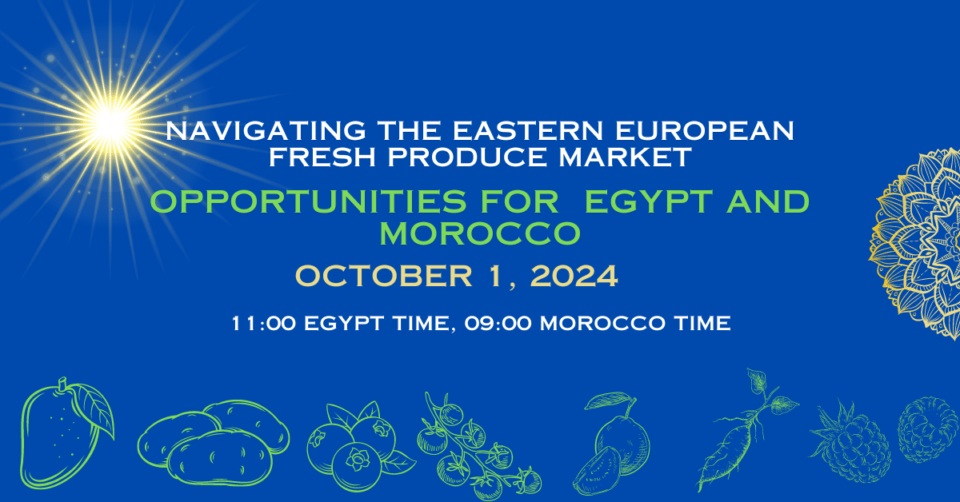Attention! The video-recording of the training is available on our Youtube channel via this link: https://youtu.be/h7R3gYIPx3M
Delve into the specifics of the fresh produce trade in the vibrant and dynamic markets neighboring Old Europe! Poland, the Czech Republic, Romania, Slovakia, Ukraine, Lithuania, Latvia, and Estonia are already important buyers of fruits and vegetables from Egypt and Morocco, EastFruit notes. However, the potential for growth in this market remains largely untapped.
When?
01 October 2024, 11:00 am Egypt Time, 09:00 am Morocco Time, 10:00 am Poland Time
Where?
Online Training (Zoom), the link will be shared with registered participants only.
For whom?
The training is open for any companies from Egypt and Morocco involved in exports of fruits and vegetables and interested in opportunities in Eastern Europe.
How to register?
Participating if free but prior registration is required. Registration form is available here
Program of the training (Egypt Time):
11:00-11:20
Eastern Europe’s market specifics (cultural, historical, consumer, and other aspects) – Andriy Yarmak, FAO Economist
11:20-11:40
Fruit & vegetable market niches for Egypt and Morocco in Eastern Europe – Yevhen Kuzin, FAO International Consultant, Horticulture Market Analyst
11:40-11:55
Morocco’s practical experience of exporting to Eastern Europe – Nabil Belmkaddem, General Manager at BestBerry Cooperative, a reliable supplier of fresh strawberries, raspberries, blueberries, and blackberries
11:55-12:10
Egypt’s practical experience of exporting to Eastern Europe – Hagar Elsayed Abdelhamid, Vice Export Manager, Green Egypt for Agricultural Investment Co. (AGREEN)
12:10-12:25
A Polish importer’s vision of Moroccan exports to Poland – Alexander Sinicki, AS Import-Export, a trader with the office in Perpignan and extensive experience in import from Morocco
12:25-12:40
A Polish importer’s vision of Egyptian exports to Poland – Dariusz Zawadka, Fruland, Poland, a trader supplying the Polish market with produce from Egypt, Turkey, Morocco, South Africa, etc.
12:40-13:00
Mission to Poland for Egypt and Morocco in November, Q&A, next steps – Andriy Yarmak, FAO Economist
Why Eastern Europe?
- Large Consumer Base. With over 111 million consumers sharing similar habits and preferences, Eastern Europe forms a substantial trade zone, either within the EU or through the FTA with Ukraine.
- Distinct Consumer Profile. The region boasts a unique consumer demographic within Europe, characterized by mature individuals who are open to experimentation and eager to embrace innovations, new tastes, flavors, and experiences.
- Robust Economic Growth. Eastern Europe often outpaces advanced EU markets in economic growth. For instance, Poland and Romania are expected to achieve real GDP growth rates of 3.5-3.6% in 2025, compared to the projected 1.5% for older EU member states.
- Strategic Trade Location. Positioned to facilitate trade between East and West, North and South, the region benefits from an almost free trade zone, well-developed road infrastructure, strong commercial connections, and extensive airport logistics.
- Growing Import Market. There has been a 28% increase in spending on fruit and vegetable imports in Eastern Europe from 2019 to 2023, now totaling $10 billion. Eastern Europe is among global import leaders in citrus, grape, watermelon, and other segments.
- Reverse Trade Opportunities. The region boasts significant opportunities for establishing bilateral and multilateral trade routes, including reverse imports of apples, pears, nuts, and various other categories.
We look forward to seeing you at the training!
Registration form is available here
The training is organized by FAO/EBRD Project: Food Security Package SEMED – Diversifying and adding value to export markets.
The use of the site materials is free if there is a direct and open for search engines hyperlink to a specific publication of the East-Fruit.com website.




